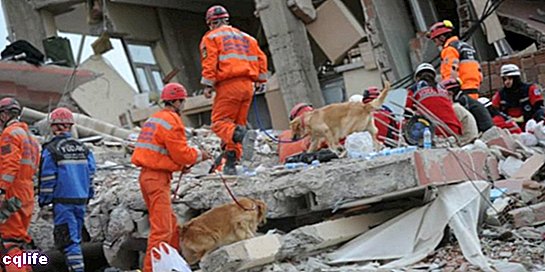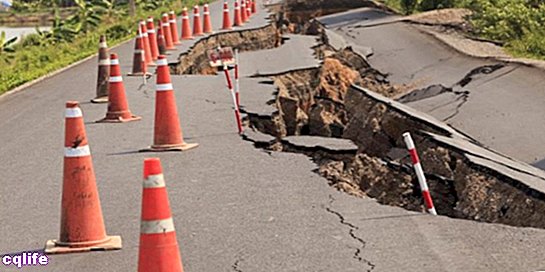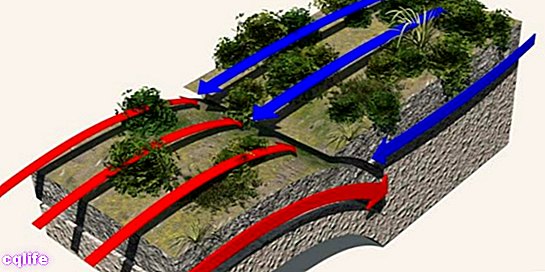- What is an earthquake?
- How does an earthquake occur?
- Causes of earthquakes
- Consequences of earthquakes
- Types of earthquake
- Elements of an earthquake
We explain what an earthquake is, how it occurs, its elements, causes and consequences. Also, what types of earthquakes exist.

What is an earthquake?
It is called an earthquake (or earthquake), tremor, earthquake or telluric movement to violent, sudden and transient shaking of the surface of the Earth, produced by the release of Energy accumulated in the subsoil, in the form of waves seismic that travel outward. That is, it is about movements regular and sudden Earth crust, which occur as a consequence of various natural geological phenomena.
Depending on their intensity, earthquakes can be almost imperceptible or bring with them gigantic disasters, not only because of their direct impact on life on the earth's surface, but because they can cause other phenomena destructive, such as tsunamis, Volcanic eruptions or earth cracks.
For this reason, and because they are difficult to predict accurately, earthquakes have been a source of fear for the population. humanity from time immemorial.
Paradoxically, earthquakes give us a lot of information about the interior of the planet. Numerous institutions are dedicated to recording the movements of the earth's crust and predicting its surface effects, in order to also be able to develop technologies construction and engineering that are more resistant and less affected, helping to prevent tragedies. Bliss science it is called seismology.
How does an earthquake occur?
Earthquakes occur when, due to some underground phenomenon (generally the tectonics of the plates), energy is accumulated in the earth's subsoil, due to the set of forces that take place there, including the gravity, the Pressure, the tall ones temperatures of the matter and the resistance of compacted materials over the millennia.
This energy must eventually be released through waves that shake matter. It will always do it according to the physical of the elements of the subsoil, moving in all directions, and that as they advance towards the earth's surface they increase in intensity, when they find softer materials.
Causes of earthquakes
The main causes of an earthquake are natural, although they can also occur as an exceptional consequence of certain human activities. A list of common causes would include the following:
Natural causes:
- The collision and friction of two tectonic plates, which not only gives rise to seismic movements, but also different types of orogeny and geological changes.
- The violent eruptions of volcanoes, which shake their surroundings as the retained magma bursts to the surface.
- Massive landslides such as avalanches or underground geological subsidence, such as the collapse of cave roofs.
- Very abrupt variations in atmospheric pressure, as in the case of cyclones.
Human causes:
- The sustained use of electricity generation geothermal, by suddenly cooling the subsoil by introducing water to evaporate, it can cause small local earthquakes.
- The “fracking” or hydraulic fracturing for the extraction of hydrocarbons, a technique that consists of increasing the cracks or ducts in which the desired substances are housed, injecting water at very high pressures.
- The underground nuclear explosions and other warlike experiments of great intensity.
Consequences of earthquakes

An earthquake may well have no visible consequences, at least for those of us on the surface. But it can also bring more or less disastrous consequences, capable of costing many lives, such as:
- Landslides and landslides, such as avalanches, landslides or partial landslides of elevations of the land.
- Ruptures and liquefaction of I usuallySince when surface materials are subjected to sudden and intense movement, they can break, separate or lose their cohesion, in the latter case becoming a white or semi-liquid substance.
- Tidal waves, floods and tsunamisIn cases where the tremor occurs in the vicinity of large bodies of water, the waves can be transmitted to the liquid and produce large waves of oversized size and other unusual behavior.
- Fires and urban damages, as a consequence of the collapse of buildings, exposing gas pipes and collapsing power lines.
Types of earthquake

Depending on their tectonic characteristics, earthquakes can be classified into:
- Interplate earthquakes, also known as subduction earthquakes, occur in regions of contact between two tectonic plates, when the pressure between them overcomes the mechanical resistance that locks them and a displacement occurs in some direction. Its intensity, in fact, depends on the amount of movement produced.
- Intraplate earthquakes of medium and high depth, similar to the previous category, but produced inside the plate and not at its ends in contact with another. They are, however, much less common.
- Cortical or superficial earthquakes, produced at shallow depths, as a consequence of the deformations and stresses suffered by the continental plates of the lithosphere, when being in a point of convergence of tectonic plates.
- Oceanic plate earthquakes, produced as their name indicates in submarine tectonic plates, especially at the beginning of subduction processes, are often associated with tidal waves.
- Transforming fault earthquakes, produced by the collision of two tectonic plates, but not in the same place of encounter, but much further away, due to the transmitted stresses and the lateral displacement produced between the found plates.
On the other hand, a second common way of classifying earthquakes is one that takes into account the depth of their focus. According to this, we would have only three categories:
- Superficial earthquakes, produced in a strip of the earth's crust no more than the first 70 kilometers deep.
- Intermediate earthquakes, produced in a greater depth that ranges between 70 and 300 kilometers underground.
- Deep earthquakes, produced outside the limits of the lithosphere, beyond 300 kilometers deep.
Elements of an earthquake
The systematic study of earthquakes has revealed that they have certain common elements, such as:
- The seismic focus or hypocenter, which is the point of origin of the underground earthquake, found at some point in the lithosphere.
- The epicenter, on the other hand, is the vertical projection on the earth's surface of the hypocenter, that is, the point on the latter that is directly above the focus of the earthquake, and is the place where the greatest amount of damage traditionally occurs.
- The magnitude, which is the force or intensity with which the earthquake occurs, and which can be measured on different seismological scales, the most famous of all being the Richter scale, named after the American seismologist Charles F. Richter.
